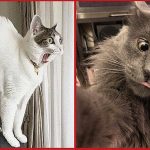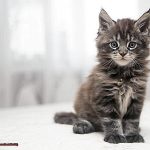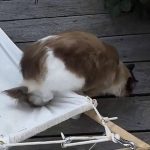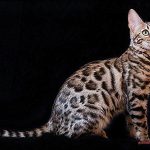As a cat lover, you know that your furry friend is prone to various health issues, just like humans. However, one condition that often goes unnoticed is strabismus. This ailment occurs when a cat’s eyes don’t align correctly and can have severe consequences if not treated promptly. As a responsible pet owner, it’s crucial to recognize the symptoms of strabismus in cats.
Have you ever seen a cat with one eye gazing straight ahead while the other appears to be staring off into space? This classic symptom of strabismus is hard to miss. But there are other telltale signs too. Cats with this condition may struggle to judge distances accurately, making jumping or catching toys challenging for them. They might also have difficulty tracking moving objects with their eyes.

However, the effects of strabismus in cats go beyond just physical quirks. The condition can cause discomfort and even pain for felines as their brain tries to process conflicting visual information. In severe cases, it can even lead to blindness. That’s why recognizing the symptoms early on is vital and seeking treatment from a veterinarian should be done without delay.
Don’t let your beloved kitty suffer in silence – keep an eye out for these symptoms of strabismus and take action immediately if you suspect something is wrong.
Common Symptoms of Strabismus in Cats
Strabismus, commonly known as “crossed eyes,” is a condition that can affect cats of any age. Although the physical appearance may be noticeable to owners, there are several other common symptoms that cats with strabismus may exhibit.
The most obvious sign of strabismus is crossed or misaligned eyes. One eye may look straight ahead while the other is pointing in a different direction, giving the cat a cross-eyed appearance. This can be particularly noticeable when the cat is looking directly at you or objects around them.
Cats with strabismus may also have difficulty with depth perception, making it challenging for them to judge distances accurately. This can lead to problems with coordination and balance, causing the cat to trip or stumble.
Another symptom of strabismus is abnormal eye movements, known as nystagmus. This can make it difficult for cats to focus on objects and may cause dizziness or disorientation.

In some cases, cats with strabismus may squint or close one eye to try to compensate for their misaligned eye. They may also tilt their head to one side in an attempt to align their eyes and improve their vision.
Behavioral changes are also common in cats with strabismus. They may become more hesitant or cautious in their movements due to their vision impairment. Additionally, they may have difficulty tracking moving objects, making it harder for them to play or hunt.
If you suspect that your cat has strabismus, it’s crucial to seek veterinary care promptly. While this condition is not usually painful or harmful to the cat’s health, it can be a sign of underlying health issues that require treatment. Your vet will be able to perform a comprehensive exam and recommend any necessary interventions to help manage your cat’s symptoms and improve their quality of life.
Crossed or Misaligned Eyes
Strabismus, commonly referred to as crossed or misaligned eyes, is a condition that can affect cats of all breeds and ages. This eye disorder occurs when the eyes are not properly aligned, causing one eye to turn inward, outward, upward, or downward.
One of the most obvious symptoms of strabismus in cats is a visible misalignment of the eyes. You might notice that while one eye is looking straight ahead, the other appears to be looking in a completely different direction. However, not all cases of strabismus are immediately noticeable, so it’s important to keep an eye out for more subtle signs.
Cats with strabismus may experience difficulty with depth perception. They may bump into objects or have trouble catching toys due to trouble judging distances. Uneven surfaces or stairs can also pose a challenge for these felines.
Strabismus can also cause eye strain and discomfort for your cat. They may squint excessively or paw at their affected eye due to discomfort. The extra effort required to focus their eyes properly can cause headaches or fatigue, leading to a decrease in your cat’s quality of life.
It’s important to note that not all cases of crossed or misaligned eyes in cats are caused by strabismus alone. Other conditions such as injury or nerve damage can also contribute to eye alignment issues. That’s why it’s crucial to consult with a veterinarian if you notice any signs of eye misalignment or other symptoms in your cat.
If you suspect your cat has strabismus, prompt veterinary care is essential for proper diagnosis and treatment. Your vet may recommend surgery or other treatments depending on the severity of the condition.
Difficulty with Depth Perception

Unfortunately, sometimes our cats experience health issues that can affect their day-to-day activities. Difficulty with depth perception is a common symptom of a condition called strabismus in cats. This eye condition causes misalignment, leading to the eyes pointing in different directions, resulting in inaccurate depth perception.
Strabismus can cause cats to bump into objects or misjudge distances when trying to jump or pounce on prey. Their brain receives two different images from each eye, which causes confusion and difficulty in processing visual information. As a result, your cat may have trouble tracking moving objects, such as toys or birds flying overhead.
Owners may notice that their cat’s eyes appear to be looking in different directions, or one eye seems to be constantly turned inward or outward. Additionally, cats with strabismus may have a head tilt or abnormal posture as they try to compensate for their vision problems.
If you suspect that your cat may have strabismus, it’s essential to seek veterinary care as soon as possible. Early diagnosis and treatment can help prevent further vision loss and improve your cat’s quality of life. Your veterinarian may recommend surgery or prescribe medication to correct the problem.
In the meantime, you can help your cat by providing plenty of toys that are easy to see and catch. You may also want to arrange furniture so that there are fewer obstacles for your cat to run into. With a little bit of extra care and attention, you can help your cat navigate their world more easily and enjoyably.
Abnormal Eye Movements
One aspect of their health that often goes overlooked is their eyesight. Abnormal eye movements, while subtle, can be indicative of a larger issue at hand – strabismus.
Strabismus is a condition in which the eyes are not aligned properly, causing them to point in different directions. This misalignment results in double vision and can lead to abnormal eye movements such as nystagmus. Nystagmus is a rapid and involuntary back-and-forth movement of the eyes that can be disorienting for your furry friend.
Cats with strabismus may also squint or blink excessively in an attempt to compensate for their double vision. This can lead to difficulty tracking moving objects or navigating their environment. However, it’s important to note that not all abnormal eye movements are indicative of strabismus. Other conditions such as vestibular disease or neurological disorders can also cause abnormal eye movements in cats.

If you notice any unusual eye movements in your cat, it’s crucial to consult with a veterinarian to determine the underlying cause and provide appropriate treatment. Early diagnosis and treatment can help your furry friend navigate the world more easily and happily.
In addition to seeking professional help, there are steps you can take as a pet owner to make life easier for your feline friend. Providing easy-to-see toys and obstacle-free spaces can help them navigate their surroundings with greater ease and confidence.
Squinting or Closing One Eye
When it comes to your cat’s eyesight, they can express a lot without even saying a word. From loving blinks to fearful wide eyes, the health of their vision is paramount. However, if you notice your cat squinting or closing one eye, it’s important to take note as this behavior could be a sign of an underlying health issue.
Strabismus, a condition where a cat’s eyes are misaligned, is one of the most common causes of squinting in cats. This misalignment can either be permanent or temporary and affect one or both eyes. Squinting or closing one eye may indicate that the eye is not functioning correctly. The cat may be attempting to compensate for the misaligned eye, or the eye could be causing discomfort or pain.
Squinting could also point to an underlying health issue such as infections or injuries. Therefore, if you notice your cat squinting or closing one eye for more than a few days, it is recommended that you seek veterinary care. Your veterinarian will perform a thorough eye examination and recommend appropriate treatment based on the underlying cause.
It’s important to note that squinting or closing one eye may be accompanied by other symptoms such as redness, discharge, or swelling around the eye. These symptoms should not be ignored and should be addressed promptly by a veterinarian.
To maintain your cat’s optimal eyesight and overall health, provide them with easy-to-see toys and obstacle-free spaces that help them navigate their surroundings with ease. Additionally, keep an eye out for any changes in your cat’s behavior or appearance regarding their eyesight.
Head Tilting
While it may seem cute or quirky at first, it could actually be a sign of discomfort or pain.
Head tilting in cats is a common symptom of strabismus, a condition that affects the alignment of their eyes. When the eyes point in different directions, the cat compensates by tilting their head to see straight. However, other underlying conditions such as ear infections or vestibular disease can also cause head tilting.
But how can you tell if your cat’s head tilting is a cause for concern? Keep an eye out for accompanying symptoms like loss of balance, disorientation, and difficulty walking. These symptoms could indicate a more serious underlying condition that requires immediate veterinary attention.
When you bring your cat to the vet, they will determine the underlying cause of the head tilt and provide appropriate treatment. Depending on the severity of the case, this may involve medication or surgery. It’s important to seek veterinary care immediately to prevent any further discomfort or pain for your feline friend.
Behavioral Changes
Cats are known for their individual personalities and quirks, but when these traits start to change, it could be a sign of an underlying health condition such as strabismus. This condition, which causes the eyes to be misaligned, can lead to numerous behavioral changes that can be subtle but significant.
One of the most common behavioral changes in cats with strabismus is a reluctance to move around or play. This is because the condition can cause dizziness, disorientation, and difficulty with depth perception, making it harder for cats to navigate their environment. Additionally, cats may have difficulty tracking moving objects, leading to a lack of interest in toys or other stimuli.
Compensating for their vision impairment, cats may display unusual head tilts or posture in an attempt to focus on objects or judge distances correctly. Unfortunately, this can also lead to cats becoming more aggressive or fearful as they struggle to adapt to their changing vision. They may not be able to accurately judge distances or anticipate movements, leading them to feel threatened or cornered.
It’s crucial to remember that cats are experts at hiding signs of illness or discomfort. If you notice any significant changes in your cat’s behavior, it’s worth taking them to the vet for a checkup. Early detection and treatment of strabismus can help prevent further vision loss and improve your cat’s quality of life.
Diagnosing Strabismus in Cats
However, diagnosing strabismus in cats can be challenging, as they may not show obvious signs of eye misalignment. Nonetheless, there are symptoms to look out for that may indicate a cat is suffering from this condition.
One of the most apparent indicators of strabismus is a visible misalignment of the eyes. By looking at your cat’s face from the front, you can notice if their eyes are not aligned in the same direction. Additionally, your cat may struggle with focusing or tracking objects with their eyes. They may appear disoriented when navigating their surroundings or have difficulty following a moving object.
Another symptom that may suggest strabismus is abnormal head positions or movements. Your cat may tilt their head to one side or continually flick their eyes back and forth.
It’s important to note that these symptoms can also be indicative of other eye conditions like cataracts or glaucoma. Therefore, it’s crucial to seek veterinary care immediately if you observe any of these signs.
To diagnose strabismus in cats, your veterinarian will perform a comprehensive eye exam. This includes measuring your cat’s visual acuity, checking for pupil response, and examining the structure of their eye. In some cases, they may perform additional tests like electroretinography or magnetic resonance imaging (MRI) to exclude other potential causes of eye misalignment.
QFWBprLYA8s” >
Conclusion
As a devoted cat owner, it’s crucial to be aware of the potential health problems that your feline friend may encounter. Strabismus is one such condition that can have serious consequences if left untreated. This disorder arises when a cat’s eyes fail to align correctly, resulting in crossed or misaligned eyes as the most apparent symptom. However, there are other signs to watch out for too.
Cats with strabismus may struggle with depth perception, making it challenging for them to jump or catch toys accurately. Additionally, tracking moving objects can be difficult for them. Apart from physical manifestations, strabismus can also cause discomfort and pain as the brain tries to reconcile conflicting visual information. In severe cases, it can even lead to blindness.
Early detection is critical in treating strabismus in cats before it leads to further vision loss and affects their quality of life. Identifying this condition can be tricky since cats don’t always exhibit clear indications of eye misalignment. However, abnormal head positions or movements and difficulty focusing on objects are key indicators.
As a responsible pet parent, being vigilant and recognizing these symptoms of strabismus is essential for your cat’s well-being.







